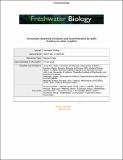Por favor, use este identificador para citar o enlazar a este item:
http://hdl.handle.net/10261/165833COMPARTIR / EXPORTAR:
 SHARE SHARE
 CORE
BASE CORE
BASE
|
|
| Visualizar otros formatos: MARC | Dublin Core | RDF | ORE | MODS | METS | DIDL | DATACITE | |

| Campo DC | Valor | Lengua/Idioma |
|---|---|---|
| dc.contributor.author | Lovas-Kiss, Ádám | es_ES |
| dc.contributor.author | Sánchez, Marta I. | es_ES |
| dc.contributor.author | Molnár, Attila | es_ES |
| dc.contributor.author | Valls, Luis | es_ES |
| dc.contributor.author | Armengol, Xavier | es_ES |
| dc.contributor.author | Mesquita-Joanes, Francesc | es_ES |
| dc.contributor.author | Green, Andy J. | es_ES |
| dc.date.accessioned | 2018-06-07T08:01:01Z | - |
| dc.date.available | 2018-06-07T08:01:01Z | - |
| dc.date.issued | 2018-02-11 | - |
| dc.identifier.citation | Freshwater Biology, 63(4): 393-404 (2018) | es_ES |
| dc.identifier.uri | http://hdl.handle.net/10261/165833 | - |
| dc.description.abstract | The red swamp crayfish (Procambarus clarkii), originally from North America, is one of the world's worst aquatic invaders. It is a favoured prey item for waterbirds, but the influence of this novel predator–prey relationship on dispersal of other organisms has not previously been considered. We investigated the potential for dispersal of plants and invertebrates by migratory waterbirds feeding on alien P. clarkii in European ricefields at harvest time. In November–December of 2014–2015, we collected propagules from the outside of 13 crayfish captured as they moved out of ricefields during harvest in Doñana, south‐west Spain. We also collected excreta (N = 76 faeces, 14 pellets) of lesser‐black backed gull (Larus fuscus). We recorded diaspores from at least 11 plant species (161 seeds from 10 angiosperm taxa, and 14 charophyte oogonia) on the outside of crayfish, together with 54 eggs from eight aquatic invertebrate taxa. Adults and juveniles of at least nine microcrustaceans, including the alien ostracods Hemicypris reticulata and Ankylocythere sinuosa, were also recovered from crayfish. No intact propagules were present in the digestive system of the crayfish. Contents of regurgitated pellets confirmed P. clarkii as the main food item for gulls. Diaspores from at least 12 plant species (154 seeds from 11 angiosperm taxa, and 17 charophyte oogonia) were recovered from gull excreta, together with 129 eggs of 12 aquatic invertebrate taxa. A statoblast of the alien bryozoan Plumatella vaihiriae was found in gull faeces. Seven of the plant species are important agricultural weeds, and two are alien to Spain. Diaspores from six plant taxa were germinated, confirming viability. These propagules were from a similar set of plants and invertebrates to those found on the outside of crayfish, suggesting that propagules in gull excreta were ingested inadvertently with their crayfish prey. Ricefields constitute a major artificial aquatic habitat covering an increasing proportion of the world's land surface and typically support native or alien crayfish. Crayfish invasion can lead to novel secondary dispersal pathways for plants and invertebrates through interactions with their predators, promoting the expansion of alien and native species (including weeds) through long‐distance dispersal via migratory waterbirds and increasing connectivity of organisms between artificial and natural ecosystems. This represents a previously overlooked impact of crayfish invasion on ecosystem services. Supporting Information | es_ES |
| dc.language.iso | eng | es_ES |
| dc.publisher | Wiley-Blackwell | es_ES |
| dc.relation.isversionof | Postprint | es_ES |
| dc.rights | openAccess | en_EN |
| dc.subject | Biological invasions | es_ES |
| dc.subject | Endozoochory | es_ES |
| dc.subject | Epizoochory | es_ES |
| dc.subject | Procambarus clarkii | es_ES |
| dc.subject | Seeds | es_ES |
| dc.title | Crayfish invasion facilitates dispersal of plants and invertebrates by gulls | es_ES |
| dc.type | artículo | es_ES |
| dc.identifier.doi | 10.1111/fwb.13080 | - |
| dc.description.peerreviewed | Peer reviewed | es_ES |
| dc.relation.publisherversion | https://doi.org/10.1111/fwb.13080 | es_ES |
| dc.embargo.terms | 2019-02-10 | es_ES |
| dc.relation.csic | Sí | es_ES |
| oprm.item.hasRevision | no ko 0 false | * |
| dc.contributor.orcid | Sánchez, Marta I. [0000-0003-1461-4786] | es_ES |
| dc.contributor.orcid | Molnár, Attila V. [0000-0001-7096-9579] | es_ES |
| dc.contributor.orcid | Valls, Luis [0000-0002-1798-4574] | es_ES |
| dc.contributor.orcid | Armengol, Xavier [0000-0002-0312-0396] | es_ES |
| dc.contributor.orcid | Mesquita-Joanes, Francesc [0000-0001-7168-1980] | es_ES |
| dc.contributor.orcid | Gree, Andy J. [0000-0002-1268-4951 23] | es_ES |
| dc.type.coar | http://purl.org/coar/resource_type/c_6501 | es_ES |
| item.fulltext | With Fulltext | - |
| item.grantfulltext | open | - |
| item.openairecristype | http://purl.org/coar/resource_type/c_18cf | - |
| item.cerifentitytype | Publications | - |
| item.openairetype | artículo | - |
| item.languageiso639-1 | en | - |
| Aparece en las colecciones: | (EBD) Artículos | |
Ficheros en este ítem:
| Fichero | Descripción | Tamaño | Formato | |
|---|---|---|---|---|
| FWB gull in press.pdf | 1,29 MB | Adobe PDF |  Visualizar/Abrir |
CORE Recommender
SCOPUSTM
Citations
38
checked on 02-may-2024
WEB OF SCIENCETM
Citations
35
checked on 18-feb-2024
Page view(s)
278
checked on 07-may-2024
Download(s)
452
checked on 07-may-2024
Google ScholarTM
Check
Altmetric
Altmetric
NOTA: Los ítems de Digital.CSIC están protegidos por copyright, con todos los derechos reservados, a menos que se indique lo contrario.
